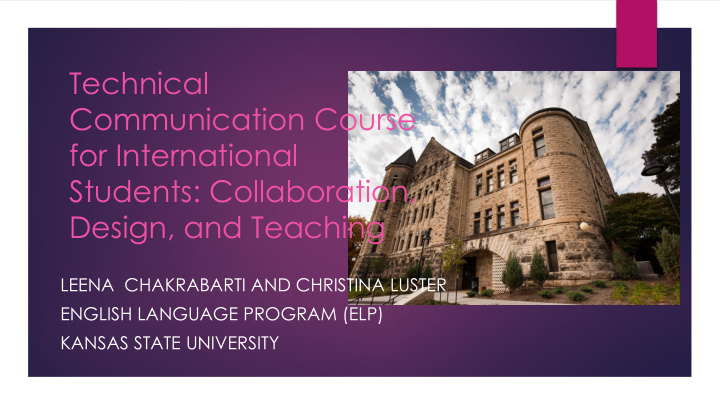



Technical Communication Course for International Students: Collaboration, Design, and Teaching LEENA CHAKRABARTI AND CHRISTINA LUSTER ENGLISH LANGUAGE PROGRAM (ELP) KANSAS STATE UNIVERSITY
Unique Qualifications that ELP brought to the table Leena Chakrabarti – Training in teaching Technical Communication for Engineers at Kansas State University Seven years of experience in teaching Technical communication for Engineers Experience in creating, advertising, recruiting students and teaching Technical Writing for International Students at the ELP Christina Luster – Coursework in technical communication Tech Committee Chair – technical expertise
Presentation Outline Creation Inception Collaboration Curriculum Literature Review Planning Teaching Assessment Lessons Learned Finished Product and Conclusion
Creation Inception Fall 2012 -- Dr. Kyung-Goo Doh of Hanyang University contacted Kansas State University Computing and Information Sciences Department (CIS) CIS contacted Division of Continuing Education and the English Language Program for proposals Proposal with SLOs and potential assignments – taken to S. Korea by our Curriculum and Assessment Director, Dr. Abby Franchitti
Creation Inception SMASH (Software Maven School at Hanyang University) Program Juniors in college Embedded Systems Course Technical Writing Course
Creation Collaboration Administrative Collaboration Dean Sue Maes, Division of Continuing Education Dr. Gurdip Singh, Department Head, CIS Mary Wood, Director, ELP Dr. Abby Franchitti, Director of Curriculum and Assessment, ELP Dr. Leena Chakrabarti, Assistant Director, ELP
Creation Collaboration Curricular Collaboration Masaaki Mizuno Embedded systems instructor Christina Luster Technical Writing instructor Leena Chakrabarti ELP supervisor Worked closely to create assignments that were relevant to both classes
Dautermann (2005) Technical writing abroad in China Students preferred style guides Collaborative learning environment Curriculum Dennett (1998) Differences between Japanese and native English Relevant users’ approach to technical writing Literature Non-native need: formal prewriting, more audience awareness, less grammar focus until final draft Hunsinger (2006) Teaching technical writing with focus on culture/nationality is ethnocentric and ineffective Instead, focus on global values and organizational culture
Curriculum CEA Accreditation Diagnostics used Planning Course Policy Course Objectives SLOs
“ Technical Writing in English is designed to address the needs on non-native English students who are interested in technical communication in its written and oral form. Curriculum This course introduces the vocabulary, conventions, forms of documents, and practices of technical communication. Emphasis will be on communication styles as they vary from field to field. Grammar and pronunciation support is also provided as needed. In this class you will create a portfolio (including a resume, project proposal, memos, analysis of reports, conference Planning poster, and a DVD of presentations) that demonstrates your knowledge of the standards of technical writing .” SLOs matched to assignments Condensed Curriculum 5 week course Tools for the workplace Language support Met computer science needs
Curriculum Teaching Structure Applying traditional principles to a non- Short lectures traditional class Workshops Style guides, modeling Translation welcome, not English only classroom
Student Samples Visual Design
Assessment Rubrics Providing Feedback Meeting students’ Written and oral feedback needs Feedback from Masaaki Students evaluated each other Capstone project and portfolio Assessed as a team
Lessons learned Collaborative process was flexible, open to critique, and welcomed change
Lessons learned Books
Finished Product Students walked away with a portfolio, including: 3 ring binder that included final products of all assignments A CD of their final presentation Certificate of completion
Recommend
More recommend